Can you use proceeds from a Relinquished Property to make improvements on a Replacement Property? The answer is yes, a https://www.accruit.com/blog/how-utilize-1031-exchange-related-party-or… Improvement Exchange offers a unique solution for transactions where an Exchanger wishes to complete improvements on land owned by a related party using a 1031 Exchange.
In this educational video, https://www.accruit.com/about/meet-team/matthew-c-douglas-esq”>Matthew Douglas, Senior Director, explains how Exchangers can utilize a 1031 Exchange to complete improvements or build new construction on land held by a related party by way of a long-term ground lease and properly structured leasehold agreement.
We also cover how the leasehold interest and completed improvements are then transferred to the Exchanger and key differences between Leasehold Improvement Exchanges and conventional Improvement Exchanges.
Category: Video Series 1031 University
-
Video: What is a Leasehold Improvement Exchange?
-
Video: What is a Leasehold Improvement Exchange?
Can you use proceeds from a Relinquished Property to make improvements on a Replacement Property? The answer is yes, a https://www.accruit.com/blog/how-utilize-1031-exchange-related-party-or… Improvement Exchange offers a unique solution for transactions where an Exchanger wishes to complete improvements on land owned by a related party using a 1031 Exchange.
In this educational video, https://www.accruit.com/about/meet-team/matthew-c-douglas-esq”>Matthew Douglas, Senior Director, explains how Exchangers can utilize a 1031 Exchange to complete improvements or build new construction on land held by a related party by way of a long-term ground lease and properly structured leasehold agreement.
We also cover how the leasehold interest and completed improvements are then transferred to the Exchanger and key differences between Leasehold Improvement Exchanges and conventional Improvement Exchanges. -
Video: What is a Leasehold Improvement Exchange?
Can you use proceeds from a Relinquished Property to make improvements on a Replacement Property? The answer is yes, a https://www.accruit.com/blog/how-utilize-1031-exchange-related-party-or… Improvement Exchange offers a unique solution for transactions where an Exchanger wishes to complete improvements on land owned by a related party using a 1031 Exchange.
In this educational video, https://www.accruit.com/about/meet-team/matthew-c-douglas-esq”>Matthew Douglas, Senior Director, explains how Exchangers can utilize a 1031 Exchange to complete improvements or build new construction on land held by a related party by way of a long-term ground lease and properly structured leasehold agreement.
We also cover how the leasehold interest and completed improvements are then transferred to the Exchanger and key differences between Leasehold Improvement Exchanges and conventional Improvement Exchanges. -
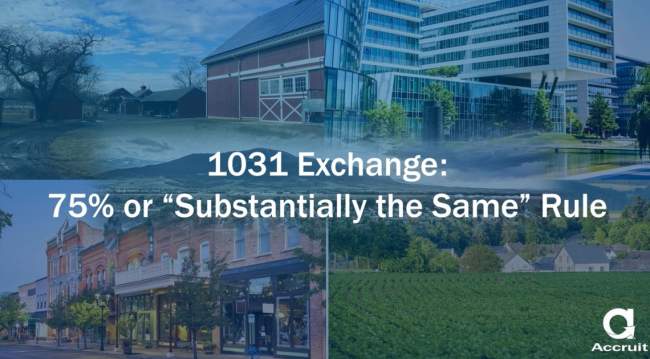
Video: 1031 Exchange: 75% or “Substantially the Same” Rule
This video explains how the rule applies to fractional ownership interests, such as https://www.accruit.com/blog/differences-between-tenant-common-investme… (TIC) or Delaware Statutory Trusts (DSTs), and how a 25% margin of error is allowed by the IRS regarding identified Replacement Properties. In this video, we also provide practical examples, such as scenarios where 75% or more of the identified property is acquired, more property than originally identified is acquired, and managing fractional DST interests. Additionally, we consider differing interpretations of the rule amongst Qualified Intermediaries (QIs).
Learn how this rule provides flexibility while remaining compliant with 1031 Exchange requirements.
-

Video: 1031 Exchange: 75% or “Substantially the Same” Rule
This video explains how the rule applies to fractional ownership interests, such as https://www.accruit.com/blog/differences-between-tenant-common-investme… (TIC) or Delaware Statutory Trusts (DSTs), and how a 25% margin of error is allowed by the IRS regarding identified Replacement Properties. In this video, we also provide practical examples, such as scenarios where 75% or more of the identified property is acquired, more property than originally identified is acquired, and managing fractional DST interests. Additionally, we consider differing interpretations of the rule amongst Qualified Intermediaries (QIs).
Learn how this rule provides flexibility while remaining compliant with 1031 Exchange requirements.
-
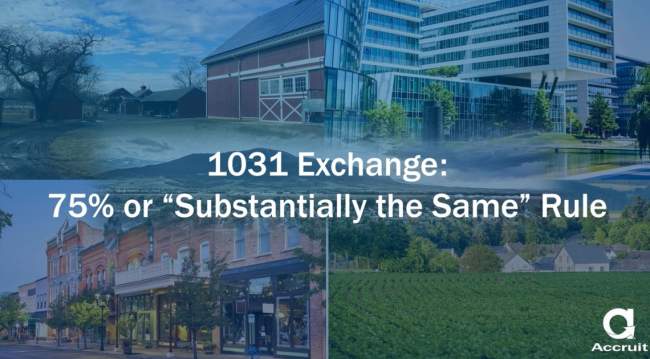
Video: 1031 Exchange: 75% or “Substantially the Same” Rule
This video explains how the rule applies to fractional ownership interests, such as https://www.accruit.com/blog/differences-between-tenant-common-investme… (TIC) or Delaware Statutory Trusts (DSTs), and how a 25% margin of error is allowed by the IRS regarding identified Replacement Properties. In this video, we also provide practical examples, such as scenarios where 75% or more of the identified property is acquired, more property than originally identified is acquired, and managing fractional DST interests. Additionally, we consider differing interpretations of the rule amongst Qualified Intermediaries (QIs).
Learn how this rule provides flexibility while remaining compliant with 1031 Exchange requirements.
-
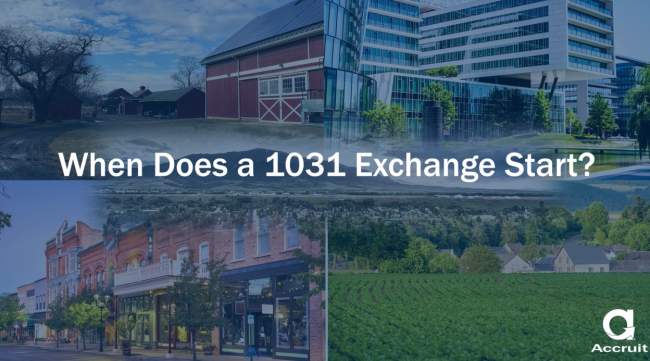
Video: When Does a 1031 Exchange Start?
When does a 1031 Exchange officially start? Some Exchangers believe it starts when the sale proceeds reach the Qualified Intermediary, but the IRS takes a different position. The exchange begins when the benefits and burdens of ownership transfer from the Seller to the Buyer.
In this video, we explain how this works using a real-world example. If a closing happens on a Friday at 5 PM and a fire breaks out the next day, whose insurance company would be responsible? The answer is the Buyer’s insurance, because the transfer of ownership has already occurred. This is the point at which the 1031 Exchange starts and when the 180-day exchange period begins.
Understanding this timing is crucial for exchangers to meet IRS deadlines and stay compliant. Watch now to learn more. -

Video: When Does a 1031 Exchange Start?
When does a 1031 Exchange officially start? Some Exchangers believe it starts when the sale proceeds reach the Qualified Intermediary, but the IRS takes a different position. The exchange begins when the benefits and burdens of ownership transfer from the Seller to the Buyer.
In this video, we explain how this works using a real-world example. If a closing happens on a Friday at 5 PM and a fire breaks out the next day, whose insurance company would be responsible? The answer is the Buyer’s insurance, because the transfer of ownership has already occurred. This is the point at which the 1031 Exchange starts and when the 180-day exchange period begins.
Understanding this timing is crucial for exchangers to meet IRS deadlines and stay compliant. Watch now to learn more. -
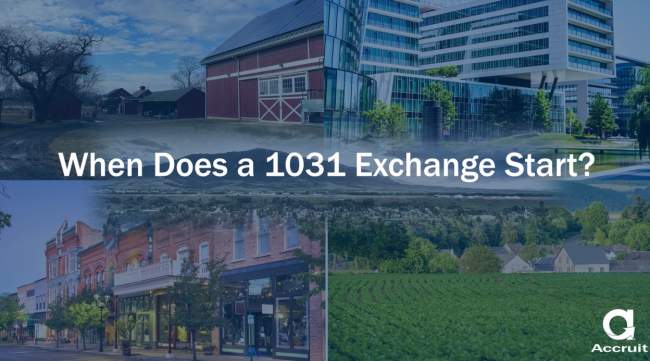
Video: When Does a 1031 Exchange Start?
When does a 1031 Exchange officially start? Some Exchangers believe it starts when the sale proceeds reach the Qualified Intermediary, but the IRS takes a different position. The exchange begins when the benefits and burdens of ownership transfer from the Seller to the Buyer.
In this video, we explain how this works using a real-world example. If a closing happens on a Friday at 5 PM and a fire breaks out the next day, whose insurance company would be responsible? The answer is the Buyer’s insurance, because the transfer of ownership has already occurred. This is the point at which the 1031 Exchange starts and when the 180-day exchange period begins.
Understanding this timing is crucial for exchangers to meet IRS deadlines and stay compliant. Watch now to learn more. -
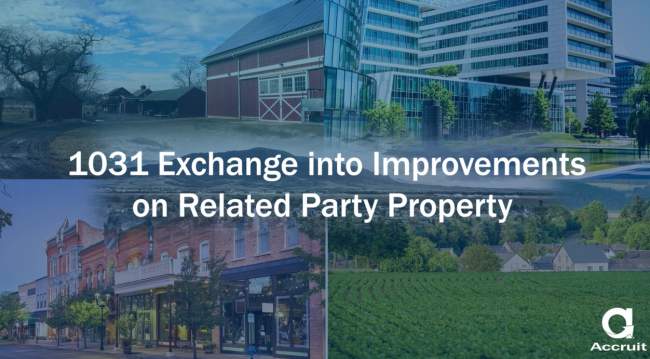
Video: 1031 Exchange into Improvements on Related Party Property
Navigating a 1031 Exchange in a low-inventory market or when lending costs are high can be challenging, especially for Exchangers looking to reinvest solely into property improvements. This video explores how a 1031 Exchange can be structured when making https://www.accruit.com/blog/can-taxpayer-use-exchange-proceeds-build-p… on related party property while complying with IRC §1031 requirements.
A critical aspect of this process is ensuring that the https://www.accruit.com/blog/same-taxpayer-requirement-1031-tax-deferre… Taxpayer owns both the Replacement Property and the ground lease while also transferring ownership of the Relinquished Property before the exchange begins. Since a long-term leasehold interest of 30 or more years is considered like-kind to a fee-simple interest, an Exchange Accommodation Titleholder (EAT) plays a vital role in holding the leasehold interest during the buildout and improvements. Ultimately, the Exchanger acquires the ground lease and tentative improvements from the accommodator.
The key takeaway is that a long-term leasehold interest of at least 30 years qualifies as like-kind to tentative improvements. If an Exchanger owns both the Relinquished and Replacement Properties, partnering with a 1031 Exchange expert like Accruit is essential to ensure the transaction is properly structured. In this video, we break down the process and key considerations to help Exchangers navigate this type of exchange successfully.